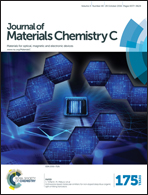Creation of near-infrared luminescent phosphors enabled by topotactic reduction of bismuth-activated red-emitting crystals†
Abstract
Bismuth-doped luminescent materials have gained significant attention in recent years owing to their huge potential for applications in telecommunications, biomedicine, and displays. However, controlled synthesis of these materials, in particular for those luminescing in the near-infrared (NIR) region, remains a challenging subject of continuous research efforts. Herein, we show that low-temperature topotactic reduction using Al metal powder as an oxygen getter can be adopted as a powerful technique for the conversion of bismuth-doped red-emitting systems into their NIR-emitting cousins. Thorough experimental characterization indicates that the framework oxygen of the hosts can be topotactically extracted, thus producing unique metal–oxygen–metal crystalline networks in reduced phases while preserving the crystalline structure of the precursor. For the first time, based on detailed analyses of X-ray absorption data, we identified that a minority of Bi atoms occupy Ba2+ sites, and most of the Bi atoms occupy the P5+ and/or B3+ sites in the as-synthesized Bi-doped BaBPO5. Subsequent topotactic treatment preferentially changes the local environment of Bi at the P5+/B3+ sites, which results in the occurrence of NIR emission owing to the birth of NIR-luminescent, defective Bi–O polyhedra in which Bi bears lower oxidation states with respect to that in the precursor. The site-specific topotactic reduction reaction reported here helps us create peculiar NIR-luminescent Bi–O units, and simultaneously does not seriously affect the red photoluminescence of Bi2+ situated at the Ba2+ sites. Given that the long-lived, ultrawide NIR emission covers the second biological window, the phosphors developed here hold great promise for in vivo luminescence and lifetime bioimaging. We anticipate that this low-temperature topotactic reduction strategy can be applied to the development of more novel Bi-doped luminescent materials in various forms that can find a broad range of functional applications.


 Please wait while we load your content...
Please wait while we load your content...